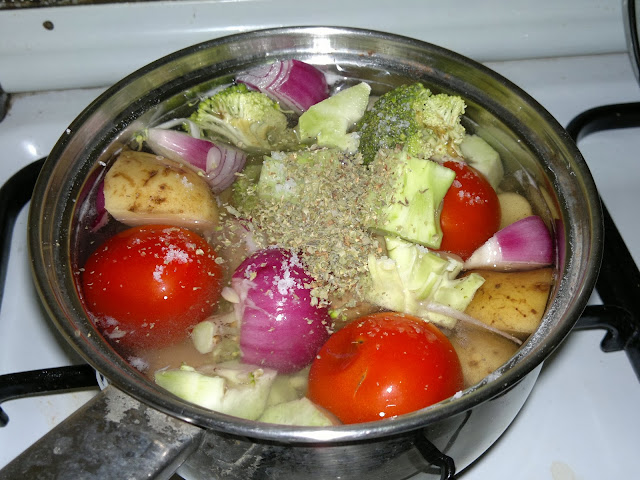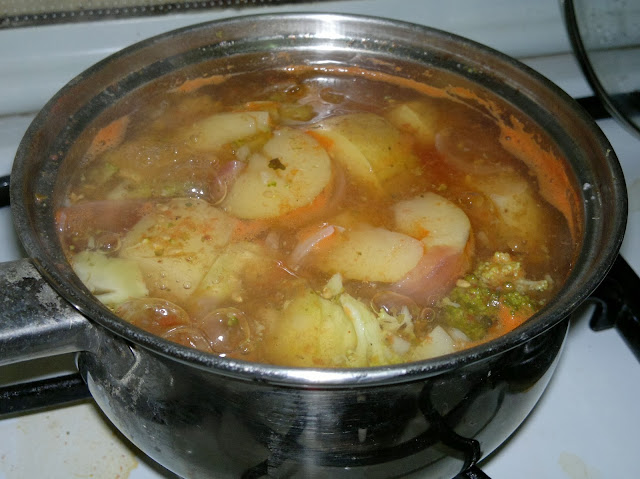This is my way of educating people on the basics of soup making. Anyone can make soup but the question of taste is always a concern. In this recipe, I will explain the rudiments of how to adjust ingredients and what the basics are to making it work.
 |
| right before cooking |
This particular recipe will give you a bowl good for 2 people (eating only this dish as a full meal) but you can adjust it proportionately so you can make more.
There are various kinds of soup and a wide variety of ingredients you can use. For this one, I used:
- 2 standard-sized potatoes
- 3 medium tomatoes
- 1 cup of chopped broccoli head
- 1 cup of chopped broccoli stalk (without the hard outer layer)
- 2 whole onions, roughly cut
- 2 cloves of garlic, crushed
- 1 teaspoon of dried marjoram (oregano) leaves
- water
- salt and black pepper for seasoning (after cooking)
Tools necessary are a sauce pan and a food processor or blender.
The process is very simple: Put all ingredients in a sauce pan; add a couple of pinches of salt; cover with about 3 to 4 cups of water (depending on how viscous or fluid you want it); bring to a boil and simmer for 15 minutes. After simmering, transfer to a food processor or blender and pulse to liquefy. Season with salt and pepper to taste and then serve.
 |
| simmering |
 |
| served with a garnish of cooked chopped broccoli head |
Depending on the available ingredients and your taste buds' preference, you can adjust what the soup contains. For example: You can use just one onion or half. You can use only one or two tomatoes, or five if it pleases you. You can omit the marjoram or use thyme. Better yet, add coriander and parsley. You can omit the broccoli and use pumpkin instead. The possibilities are endless. Just don't go crazy.
If something isn't desirable eaten in a salty scenario, don't use it—or if you have to use it, don't use too much. Take carrots, for instance. It's a good vegetable but I think it makes soup cloying if you use a lot. Don't use too much of ingredients that are strong unless they have a necessary appeal like tomatoes. They are lovely and most of us wouldn't mind a lot of them in soup. Heck, you can even make them your primary ingredient. Onions, as well, are great—as in French onion soup. More than three cloves of garlic, however, in a bowl of soup that serves two people, is not very palatable.
Your choice of herbs will affect the taste, too. Coriander, marjoram, thyme and parsley are great for soups. You can add lots of parsley and coriander but not really thyme and marjoram. They're very imposing. So are other herbs like tarragon, basil, mint, rosemary and sage. While they are acceptable in small quantities, they might give you the feeling that you're drinking an infusion rather than eating soup if you use too much.
Experimentation is necessary in the art of soup making. You'll find that the more mistakes you make, the more you get better. Mistakes are how I came up with these guidelines. Make soup making a habit and you'll get the hang of it as the days come by.

No comments:
Post a Comment
Go ahead and be awesome!